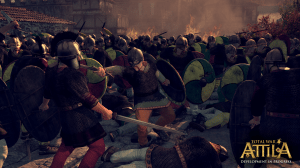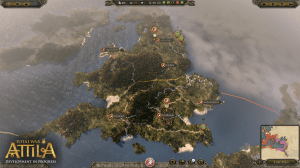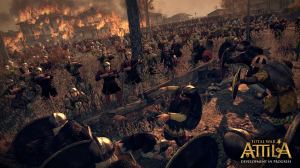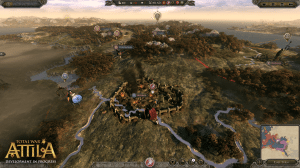 In this exclusive interview, James Blake Wiener of Ancient History Encyclopedia speaks to Janos Gaspar, Lead Designer of Total War: Attila, about Creative Assembly’s newest historical video game.
In this exclusive interview, James Blake Wiener of Ancient History Encyclopedia speaks to Janos Gaspar, Lead Designer of Total War: Attila, about Creative Assembly’s newest historical video game.
JW: What provided the impetus for Creative Assembly to make Total War: Attila? Why create a computer game about the Hunnic invasions of Europe (c. 370-469 CE) and the decline of the Roman Empire given the popularity of the Roman Total War series?
JS: In Rome II, we told the story of Rome becoming the world’s first superpower — from its first steps outside of Italy to the major body of its conquests; from a small republic to a vast empire. This time, we jumped almost 400 years into the future — right to the brink of the so-called “Dark Ages” — in order to recreate the last moments of this glorious empire and the birth of the new Europe. One of the major catalysts for such profound change is Attila himself. Overall, we thought it would be a fascinating era to cover.
 JW: Much of what we know about the Huns comes from the primary sources of their enemies; principally, the Romans. How did Creative Assembly re-imagine this period of turmoil? What specific challenges did you and the design team face?
JW: Much of what we know about the Huns comes from the primary sources of their enemies; principally, the Romans. How did Creative Assembly re-imagine this period of turmoil? What specific challenges did you and the design team face?
JS: The biggest challenge was the general lack of information about nomadic people like the Huns. There are written sources about them and there is archaeological evidence, but we have no real insights into their everyday life or culture in the way we do for, say, ancient Rome or Greece. The time period didn’t help us either, as the game is set in a time of tremendous turmoil, so resources are relatively scarce. To counterbalance this, we built up an extensive bibliography of monographs, archaeological reports, contemporary sources, and edited volumes of works about this era. With the help of these sources, we feel we’ve built a compelling and believable representation of the period.
JW: How does this game differ from others in your opinion?
With Total War: Attila, we took a slightly different direction compared to our previous games. For example, our time frame is fuzzier than before. In earlier games we had a set start date and a proposed end date: We focused all technologies, methods, and developments to this window. For Attila, we opened up the end a bit; if you focus on something you can find yourself using concepts from the seventh or eighth century CE, so you can be quite a bit ahead of the curve in certain aspects if you neglect others.
The other big change is the theme of the game; this time around, we tried to build a bit more on the “zeitgeist.” The game’s narrative is delivered from the perspective of fourth or fifth century CE Christians, and Attila is the punishment for the Roman Empire’s sins and decadence. He is the very herald of the divine apocalypse.
Climate change is also something important in the gameplay. Late Antiquity was characterized by the cooling climate. This was an important component in the mass migration that shook the foundations of the Roman Empire, leading to its collapse in Western Europe. In Total War: Attila, this is the main factor that drives nomadic peoples towards the west and the south.
JW: Do you believe that this game could be used in classrooms? If so, how and why? This is a topic currently debated by educators in North America and Europe.
JS: Total War games are well known for their historical authenticity. Despite being a sandbox game (the game can diverge from actual historical events pretty fast), the events and scenarios are still plausible and offer a good overview for a given historical era. 3-D battles can provide a spectacular reference for the engagements, while the campaign game is good for more broad information about the economy and societies pertaining to a specific time period.
 JW: The Hunnic Empire collapsed almost as quickly as it appeared, but in the West we’re left with an indelible impression of Attila (r. 434-453 CE). While demonized by many over the centuries, Hungarians, on the other hand, regard Attila as a national hero, and he is even a character in the Nibelungenlied, the national epic of Germany. In your own words, how do you think we ought to remember Attila? What is his legacy if one exists?
JW: The Hunnic Empire collapsed almost as quickly as it appeared, but in the West we’re left with an indelible impression of Attila (r. 434-453 CE). While demonized by many over the centuries, Hungarians, on the other hand, regard Attila as a national hero, and he is even a character in the Nibelungenlied, the national epic of Germany. In your own words, how do you think we ought to remember Attila? What is his legacy if one exists?
Attila’s legacy is an interesting one. As well as the Nibelungenlied, he appears in various Eddas and Norse sagas, though as you correctly point out, he’s most revered in Hungary. From the 12th century CE, the Hungarian kingdom identified “Magor,” the legendary ancestor of the Árpád dynasty and the brother of “Hunor,” as the legendary, founding king of the Huns. The Gesta Hunnorum et Hungarorum — written mainly by Simon of Kéza around 1282-1285 CE — and The Chronicon Picta — completed sometime before 1360 CE — are two medieval chronicles from Hungary. These are the first known sources to establish a bloodline connection between the Huns and the Hungarian people. This connection was widely accepted as valid and true throughout the medieval Europe.
 In more recent studies, many theories have arisen to identify the true heritage of the Huns, but none of them is firm. One thing’s for sure though: Attila was both feared and revered. He was the man who conquered half of the known world in his time. He transformed the world around him; he tore the Roman world apart and built a vast empire. Attila, for his contemporaries, was the equal of Alexander the Great, and part of something bigger; indeed, something divine.
In more recent studies, many theories have arisen to identify the true heritage of the Huns, but none of them is firm. One thing’s for sure though: Attila was both feared and revered. He was the man who conquered half of the known world in his time. He transformed the world around him; he tore the Roman world apart and built a vast empire. Attila, for his contemporaries, was the equal of Alexander the Great, and part of something bigger; indeed, something divine.
All images featured in this interview belong to Creative Assembly and have been given to Ancient History Encyclopedia solely for the purposes of this interview. Unauthorized reproduction of text and images is strictly prohibited. Special thanks is given to Mr. Gaspar for his time and consideration. Mr. James Blake Wiener was responsible for the editorial process. The views presented here are not necessarily those of the Ancient History Encyclopedia (AHE). All rights reserved. © AHE 2014. Please contact us for rights to republication.